Recent Storm Damage Posts
Flood Preparedness: How to Safeguard Your Home and Family
11/26/2024 (Permalink)
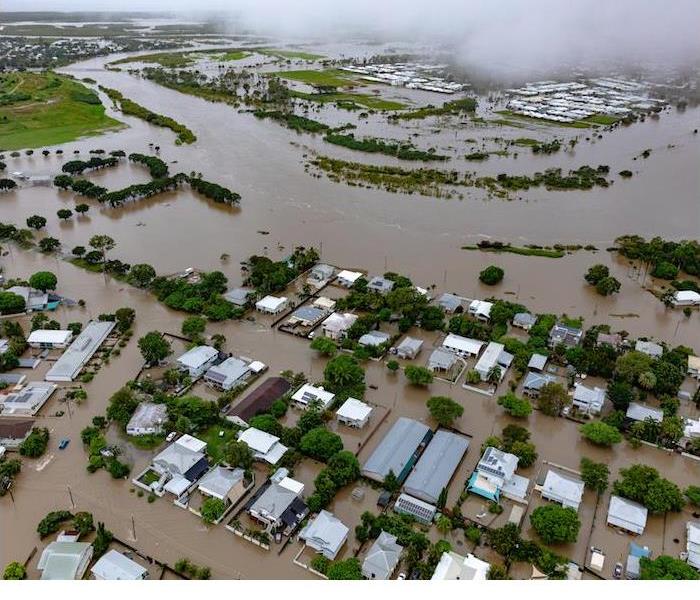 Prepare your home and family for floods.
Prepare your home and family for floods.
Flooding is one of the most common and devastating natural disasters that can impact homes and communities. Whether caused by heavy rainfall, storm surges, or melting snow, floods can result in significant property damage and pose serious risks to personal safety. At SERVPRO®, we understand the importance of being prepared for such emergencies.
Understanding Flood Risks
The first step in flood preparedness is understanding the specific risks in your area. Different regions have varying flood patterns and vulnerabilities, making it crucial to familiarize yourself with local flood zones and history. Check with local government resources or the Federal Emergency Management Agency (FEMA) to learn about your area’s flood risk. Knowing whether your home is located in a flood zone can help you take proactive measures. Additionally, monitor weather forecasts and warnings during heavy rainfall seasons. Staying informed about potential flooding events allows you to react quickly and appropriately.
Equipping your home with flood-resistant features can also mitigate risks. Elevating electrical systems, installing sump pumps, and utilizing flood barriers can significantly reduce the potential for water damage. These preventive measures not only safeguard your property but can also provide peace of mind during heavy storms.
Creating a Flood Emergency Plan
Having a well-thought-out emergency plan is vital for keeping your family safe during a flood. Begin by identifying multiple evacuation routes from your home and local community. Make sure all family members are aware of these routes and practice the plan together. Designate a meeting point outside of your neighborhood where everyone can gather if you become separated.
Prepare an emergency kit that includes essential items such as water, non-perishable food, medications, flashlights, batteries, and first-aid supplies. Don’t forget to include important documents, such as insurance policies and identification, stored in a waterproof container. This kit should be easily accessible and ready to go in case of an emergency.
It’s also wise to stay connected with your community through local alerts and notifications. Many cities have emergency alert systems that provide real-time updates on weather conditions and potential flooding. By being proactive, you can ensure your family is prepared for any situation that may arise.
Taking Action After a Flood
In the unfortunate event that your home does experience flooding, knowing how to respond can significantly reduce damage and promote safety. First, ensure that it’s safe to return to your home before entering. Check for structural damage and avoid contact with floodwaters, as they may contain hazardous materials.
Once you’re safely inside, document the damage for insurance purposes by taking photos and videos. Remove any standing water as quickly as possible, as lingering moisture can lead to mold growth and further damage. SERVPRO specializes in water damage restoration and can help you navigate the recovery process.
Floods can be devastating, but with proper preparation, you can protect your home and loved ones. Start by understanding your flood risks and creating a comprehensive emergency plan. If you ever find yourself facing the aftermath of a flood, remember that SERVPRO can help. Our dedicated team is available 24/7/365 to assist with water damage restoration and ensure your home returns to its pre-flood condition.
Steps to Take After Storm Damage: A Guide for Residents
9/16/2024 (Permalink)
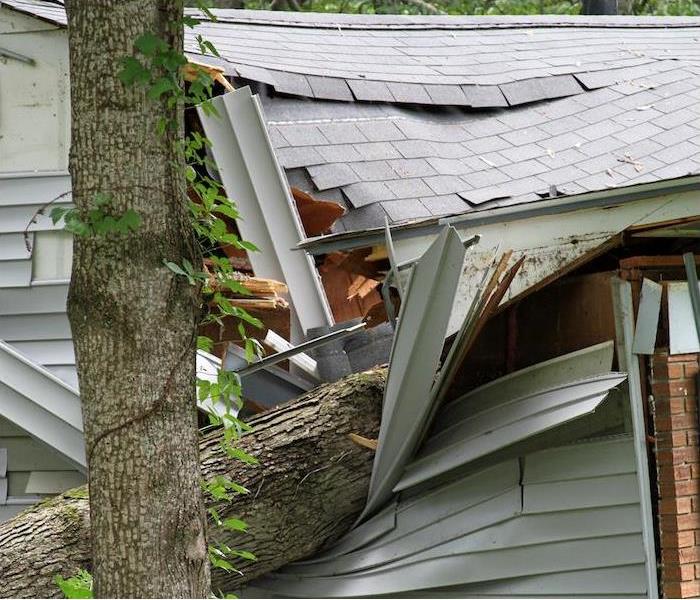 Don't delay! When storm damages affects your property, call SERVPRO.
Don't delay! When storm damages affects your property, call SERVPRO.
The weather in the fall can be both beautiful and unpredictable, with autumn colors giving way to powerful storms that can cause significant damage to homes and businesses. If you’ve experienced storm damage in your area, it’s important to act quickly and strategically to mitigate further issues and begin the recovery process.
Here’s a comprehensive guide to help you manage storm damage effectively.
Ensure Safety and Assess the Damage
- Following a storm, your immediate concern should be safety. Start by evaluating the exterior of your property. Look for visible damage such as broken windows, compromised roofing, or fallen trees. Exercise caution, as structures affected by storms can be unstable and dangerous.
- Before you enter your home or business, check for potential hazards. Be on the lookout for gas leaks or electrical issues. If you detect a gas leak or hear unusual sounds, evacuate the property and contact your gas provider immediately. For electrical problems, avoid using any appliances and reach out to a licensed electrician for a thorough inspection.
- Once it’s safe to proceed, document the damage meticulously. Take clear photographs and detailed notes of both interior and exterior damage. This documentation is essential for filing insurance claims and evaluating repair needs. Maintain a record of all interactions with insurance companies and contractors to streamline the claims process and ensure comprehensive restoration.
Contact Your Insurance Provider and Begin the Claims Process
- After assessing the damage and ensuring safety, the next critical step is to contact your insurance provider. Report the storm damage as soon as possible and provide them with the detailed documentation you’ve gathered. This will help initiate your insurance claim and facilitate the process of getting your property repaired.
- Your insurance provider will guide you through the claims process, which may include an adjuster visit to assess the damage. Be prepared to discuss the extent of the damage and any immediate repair needs. Keeping thorough records of all communications with your insurance company will help support your claim and ensure a smoother recovery.
- While waiting for the insurance adjuster, avoid making permanent repairs until they have evaluated the damage. However, you should take temporary measures to prevent further damage, such as covering broken windows with tarps or boarding them up. This helps protect your property from additional issues, such as water infiltration.
Seek Professional Restoration Services
In the aftermath of a storm, taking swift and informed action is essential to minimizing damage and ensuring a successful recovery. By assessing the damage, working with your insurance provider, and enlisting professional restoration services, you can navigate the recovery process more effectively and restore your property with confidence.
With your insurance claim in progress and temporary measures in place, it’s time to engage professional restoration services. At SERVPRO®, we specialize in storm damage restoration and are equipped to handle all aspects of the recovery process. Our team has the expertise and tools necessary to address water damage, mold growth, and structural repairs effectively.
Living the City Life: Understanding the Dangers of Storms
7/15/2024 (Permalink)
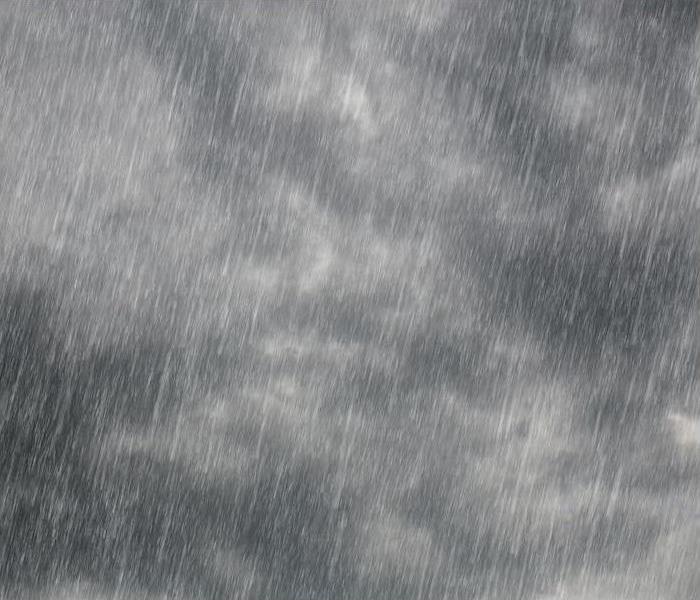 When storms strike, call us to restore your property to preloss condition.
When storms strike, call us to restore your property to preloss condition.
Living in a city brings with it a unique set of challenges when it comes to weathering storms. While urban landscapes offer convenience and opportunities, they also present specific risks during severe weather events that residents must be aware of and prepared for.
Urban Flooding: A Hidden Threat
One of the most significant dangers of storms in cities is urban flooding. As metropolitan areas expand, natural absorption areas like grasslands and wetlands are replaced with impermeable surfaces such as concrete and asphalt. When heavy rain falls, these surfaces prevent water from soaking into the ground, leading to rapid runoff.
Overwhelmed storm drains can quickly cause streets to flood, turning city roads into hazardous waterways. Flooded roads not only pose risks to drivers but also increase the likelihood of accidents and vehicle damage.
Infrastructure Vulnerabilities
City dwellers also face the risk of infrastructure vulnerabilities during storms. Older cities may have outdated sewer systems that struggle to cope with heavy rainfall, leading to sewage backups and contamination.
Additionally, power outages caused by lightning strikes or fallen trees can disrupt essential services such as public transportation and emergency response systems. In densely populated areas, the impact of such disruptions can be widespread and prolonged, affecting the daily lives of thousands.
High-Rise Hazards: Wind and Debris
In cities with skyscrapers and tall buildings, wind poses a unique threat during storms. High-rise structures can create wind tunnels that amplify gusts, making walking or driving in certain areas hazardous.
Loose debris, such as signage or construction materials, can become airborne projectiles, endangering pedestrians and vehicles below. The combination of strong winds and falling debris underscores the importance of securing outdoor items and taking shelter indoors during severe weather warnings.
Protecting Your Property and Safety
While living in a city presents challenges during storms, there are proactive steps residents can take to mitigate risks and protect themselves:
- Stay Informed: Monitor weather forecasts and alerts to stay ahead of approaching storms.
- Prepare Your Property: Clear gutters and drains to minimize flood risks, secure outdoor furniture, and trim trees to reduce the likelihood of wind damage.
- Have a Plan: Establish an emergency plan that includes evacuation routes and a communication strategy with family members.
Be Storm-Ready in the City
As urban populations grow and weather patterns become more unpredictable, understanding the specific risks of storms in a city environment is essential. By recognizing the threats posed by urban flooding, infrastructure vulnerabilities, and high-rise hazards, residents can take proactive measures to safeguard their property and ensure their safety. Stay informed, stay prepared, and stay safe during storm season in the city.
Prepare for Storms
7/9/2024 (Permalink)
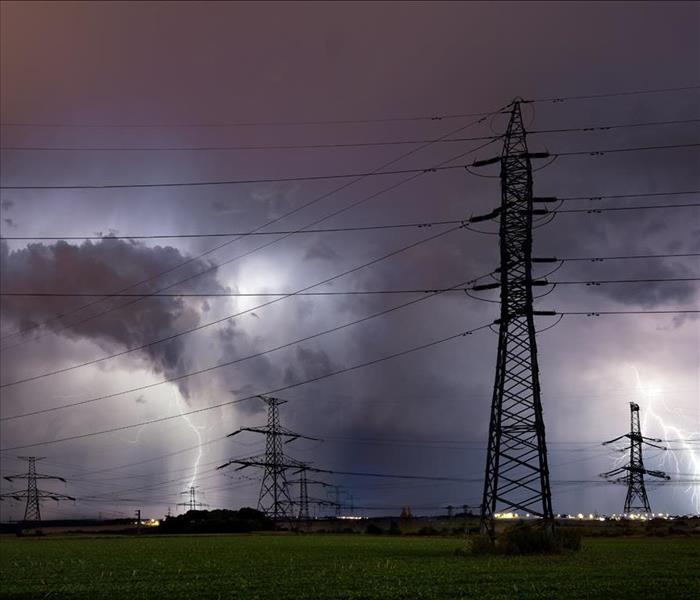 Storms can be dangerous weather events that leave destruction to your property.
Storms can be dangerous weather events that leave destruction to your property.
Storms can be dangerous weather events that leave destruction to your property as well as cause injuries. Below is a checklist to make sure your home and family are best prepared for any storms, so that you, your loved ones, and your home can stay safe.
- Prepare a Storm Shelter. Include essential supplies such as food, water, a first aid kid, flashlights, and batteries to last a few days in the case of a severe storm or tornado.
- Clear Branches and Dead Trees Around Your Home. The high-speed wind of storms can send dead branches or even trees crashing through your windows, siding and roof. Clearing these objects away from your house is an easy way to make sure they do not cause any damage.
- Secure Outside Objects. If a bad storm is coming up, move large outdoor objects inside to prevent damage to your house and those objects.
- Document Your Valuable Items. Take pictures of valuable items that you can use to show to your insurance provider. If they are damaged or lost in the storm, you’ll have better luck with your claim if you have documentation. Include date of purchase and purchase amount if you have that as well. Bonus points for saving receipts!
- Protect Your Pets. When preparing for storms, pets’ needs can be forgotten about. Make sure to have a plan in place for your pets, whether that is in your storm shelter or if that means having them in a separate safe location for when the storm hits.
Navigating the Aftermath: Recovering from Tornado Damage
7/2/2024 (Permalink)
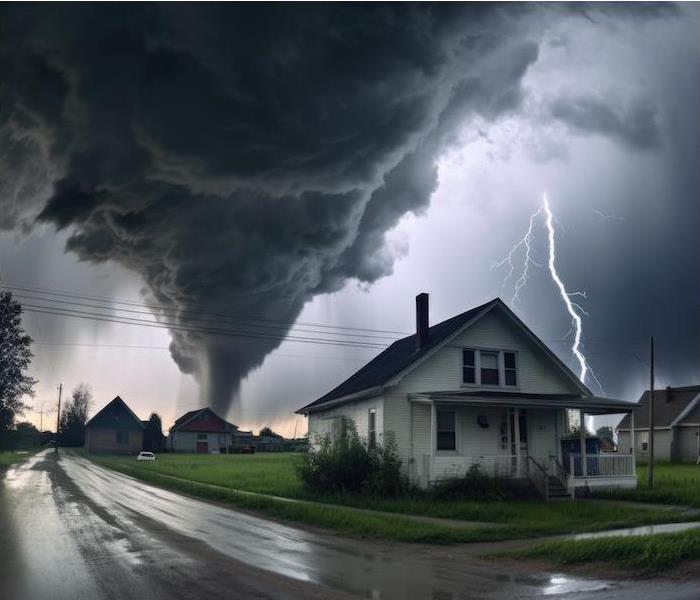 We can help after intense summer storms affect your home or business.
We can help after intense summer storms affect your home or business.
Tornadoes are unpredictable natural disasters that can wreak havoc on homes and businesses. In the aftermath of a tornado, it’s common to feel overwhelmed and unsure of the next steps to take. However, understanding what to do immediately after experiencing tornado damage can streamline the recovery process and mitigate further harm.
Here’s a comprehensive guide on how to handle tornado damage:
Prioritizing Safety Above All
- Assessing Immediate Hazards: Begin by ensuring the safety of yourself and others. Look out for any immediate dangers such as downed power lines, gas leaks, or structural instability. If you encounter any hazards, evacuate the area promptly and contact emergency services for assistance. Safety should always be the primary concern in the aftermath of a tornado.
- Conducting a Thorough Inspection: Once it’s safe to do so, conduct a detailed assessment of your property to gauge the extent of the tornado damage. Check for structural damage, including roof damage, broken windows, and compromised walls. Take note of any areas where water may have infiltrated the building, as water damage can exacerbate the situation if left unaddressed.
Taking Swift Action
- Addressing Emergency Repairs: After evaluating the damage, prioritize emergency repairs to prevent further deterioration of your property. Consider tarping roofs, boarding up windows, and sealing any openings to mitigate additional damage caused by exposure to the elements. Promptly addressing these issues can help safeguard your property while awaiting more extensive repairs.
- Mitigating Water Damage: Tornadoes often bring heavy rainfall, leading to water damage inside buildings. If your property has experienced water intrusion, take immediate action to extract standing water and commence the drying process. Mold growth can begin within 24-48 hours of water damage, underscoring the importance of swift intervention. Consider enlisting the services of a professional water damage restoration company like SERVPRO® for expert assistance with water extraction and drying.
Documenting Damage and Initiating Insurance Claims
- Thorough Documentation: To facilitate the insurance claims process, meticulously document the tornado damage. Capture photographs and videos of the damage from various angles, encompassing both the interior and exterior of your property. Maintain detailed records of any emergency repairs or expenses incurred as a result of the tornado damage.
- Contacting Your Insurance Provider: Upon documenting the damage, promptly reach out to your insurance provider to initiate a claim. Furnish them with the evidence you’ve gathered, including visual documentation and written descriptions of the damage. Maintain clear communication with your insurance company and adhere to their guidance to expedite the claims process smoothly.
Understanding Flash Flood Warnings in the City
6/17/2024 (Permalink)
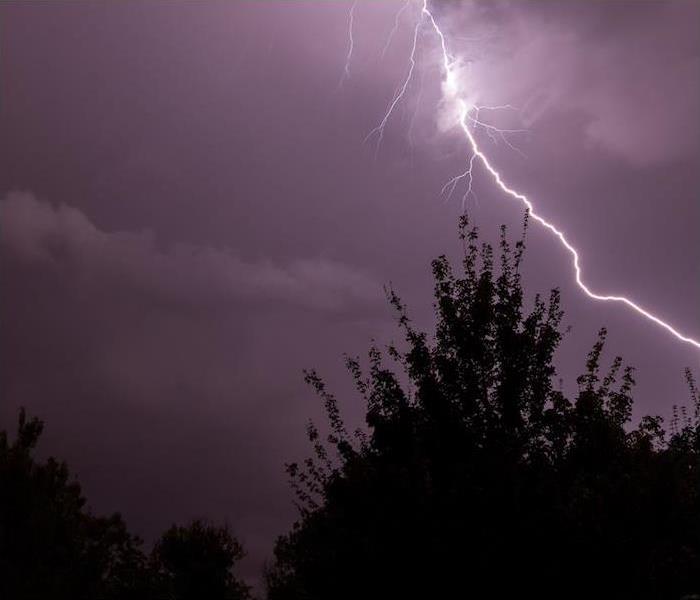 Whether its storm damage cleanup or restoration, SERVPRO is ready to respond in a moment's notice to your call.
Whether its storm damage cleanup or restoration, SERVPRO is ready to respond in a moment's notice to your call.
Living in the city, particularly in areas prone to flash flooding, means being vigilant and prepared for sudden weather changes. Flash floods occur when heavy rainfall overwhelms drainage systems, causing water to rapidly accumulate and flood streets, homes, and businesses. Understanding what to do when a flash flood warning is issued is crucial for protecting yourself, your loved ones, and your property.
Flash flood warnings are issued by the National Weather Service when flooding is imminent or already occurring in our area. These warnings typically include information about the location and severity of the flooding, as well as safety recommendations for residents. It’s essential to take flash flood warnings seriously and respond promptly to minimize the risk of injury or property damage.
Steps to Take During a Flash Flood Warning
When a flash flood warning is issued for your area, it’s important to take immediate action to ensure your safety. Here are some steps you can take during a flash flood warning:
- Stay Informed: Monitor local news outlets, weather apps, and emergency alert systems for updates on the situation. Pay attention to evacuation orders and other instructions from local authorities.
- Seek Higher Ground: If you live in a low-lying area or near a body of water, move to higher ground immediately. Avoid walking or driving through flooded areas, as water levels can rise rapidly and pose a significant risk.
- Secure Your Property: Take steps to protect your home and belongings from flood damage. Move valuables to higher floors, elevate appliances and furniture, and secure outdoor items to prevent them from being swept away by floodwaters.
- Stay Indoors: If you’re already indoors when a flash flood occurs, stay there until it’s safe to venture outside. Avoid basements and lower levels, as they can quickly flood during heavy rain.
- Avoid Flooded Areas: Never attempt to walk, drive, or swim through flooded areas, as it’s impossible to gauge the depth or strength of the water. Even shallow floodwaters can be powerful enough to sweep you off your feet or carry away vehicles.
After the Flood: Steps for Recovery
Once the flash flood has subsided and it’s safe to return to your home or business, it’s important to take steps to assess the damage and begin the recovery process. Here are some steps to take after a flash flood:
- Assess the Damage: Carefully inspect your property for damage, including water damage, structural issues, and electrical hazards. Document the damage with photographs or videos for insurance purposes.
- Contact Your Insurance Provider: Contact your insurance provider as soon as possible to file a claim for flood damage. Be prepared to provide documentation and evidence to support your claim.
- Cleanup and Restoration: Remove standing water and debris from your property and begin the drying out process to prevent mold and mildew growth. Consider hiring a professional restoration company like SERVPRO® to assist with cleanup and restoration efforts.
- Prevent Future Flood Damage: Take steps to mitigate future flood damage by installing flood barriers, improving drainage systems, and elevating utilities and appliances.
Storm Planning for Anxious Kids
5/15/2024 (Permalink)
 When the storm has passed, call SERVPRO®.
When the storm has passed, call SERVPRO®.
Thunder roars, lightning flashes and the tornado sirens blare, causing your dog to pace and your children to panic. Storm situations can be scary, especially during the summer when strong storms and tornadoes are more common. However, while we cannot control the weather, we can prepare and respond to it in ways that keep everyone calm.
This is particularly important for young children. Read on as our team explains some simple ways to incorporate storm preparation into your family routine, ensuring everyone stays calm and collected during an emergency.
Recognizing the Signs of Inclement Weather
While we can all differentiate between a sunny and cloudy day, not everyone knows what to look for as the weather changes. Even if the weather forecast does not predict storms, it is important to watch the sky. Teach your children to recognize the signs of an impending storm, such as rotating clouds, a dark or green sky, rumbling thunder and lightning that may signal a potentially dangerous storm.
It is also important to teach your kids to recognize the sound of a tornado siren and when it might go off. When the sirens are being tested, use the opportunity to help children become more familiar with the sound so that they are not frightened when it goes off during an emergency. Encourage them to listen for the siren and time how long it takes to reach your safe shelter location.
Preparing for the Incoming Weather
Have you created a storm emergency plan with your family? This includes discussing how and when to get to your safe shelter location and ensuring that your emergency kit is packed and ready to go. Choose the lowest level of your home and find an innermost room, preferably without windows. Keep a small gathering area clear at all times.
If possible, move a heavy object such as a table or desk into the room. Have your kids practice building a fort around the space and huddling inside together.
You should also involve your children in packing your emergency kit. Start with the essentials and let them help you choose what goes into the bag, including some of their favorite foods and snacks and shelf-stable water for the entire family.
Have kids pick out a flashlight and label it with their name, and don’t forget to include extra batteries, candles, matches, and any medications or prescriptions that may be required. Finally, let your kids choose some special games or activities that are only played during severe weather situations. If you lose power or need to stay sheltered for an extended period of time, you will be thankful for the added distraction.
Staying Calm
Severe weather can be frightening, even for adults, so it is natural for children to be anxious about storms and severe weather planning. It can help to explain that the chances of experiencing severe destruction or suffering from a direct tornado hit are relatively low.
Most home damage during storms, even small tornadoes, is typically focused on the roof, siding and surrounding property. The focus should be on keeping children calm and distracted during a weather event. Narrating the events in a light-hearted way may help, and it is important to stay confident and calm so that children feel secure. Together, your family will be able to tackle severe weather with much more confidence.
Start With What You Know: Preventing Flood Damage
4/1/2024 (Permalink)
 SERVPRO is ready to help in a moments notice after spring showers leak in to your home or business.
SERVPRO is ready to help in a moments notice after spring showers leak in to your home or business.
When you get stumped with a problem, how do you tackle the situation? Do you jump in without having all of the details or do you break it down to the basics to make sure you have all your bases covered?
Of course you take the time to make sure you are getting it right! This concept applies to all kinds of scenarios, but especially when it comes to preparing for and preventing home damage. Starting with the basics can help your home avoid some pretty significant damage.
Unfortunately, situations like floods can happen unexpectedly, so doing these tasks below right now will help keep your home dry and your family safe no matter what is in store for you this season.
Knowing the Zones in Detroit
Flooding is often associated with Mother Nature, but that isn’t always the case when water begins pouring down from your ceilings or leaking onto your floors. Flooding conditions can also happen when water lines burst in the streets or if your washing machine finally gives out mid-cycle.
Even though we live in a relatively urban area, we can still experience flooding situations due to the weather. Strong storms and high water levels in the waterways around us can cause trouble unexpectedly. Knowing the risk level for your own home can help you stay in control as the conditions change around us.
You should still be on high alert even if your property hasn’t necessarily flooded in the past. If you live in a low-lying area or your yard slopes even a little bit toward your house, you could wind up with water where you don’t want it. Extend your downspouts if you can, add extra drainage to your yard or consider adding a rain garden to help give all that water a more productive place to go.
If you live in a neighborhood with trees, check your gutter system regularly to remove potential leaf buildup and consider installing gutter covers to help keep that debris out of your system.
Further Prevention Tips
While it is important to know your home’s specific risk ahead of time, dealing with flooding issues can actually teach you about your home so you can take measures to prevent the flooding from happening again.
For example, if your basement door lets water in often, it would be worth having your yard evaluated to see if a professional grading can help encourage the water to flow somewhere else.
If one of your window panes gets wet every time it rains, you can address this issue easily with some fresh caulk to seal off any gaps. Finally, having your sump pump inspected regularly can help alert you to any emerging issues so you can address repairs before the next time it rains.
When you start with what you know, you can set yourself up for success no matter the season or weather situation. Enjoy the spring weather and give us a call if you are in need of any home damage repairs.
Do you have water damage in your home? Contact us at SERVPRO® for fast recovery.
Storm Damage Services
4/1/2024 (Permalink)
 When water damage strikes, a fast response is critical.
When water damage strikes, a fast response is critical.
Severe storms can cause heavy rainfall which can lead to flooding which can lead to unwanted water damage to your business in no time. SERVPRO® wants local residents to know that when a storm damages your commercial property, our highly trained professionals will respond to cleanup and restore your property to pre-damage condition. Our ability to immediately respond to a storm emergency helps to minimize the damage and the cleaning and restoration costs.
Here are Some of the Services We Provide:
- Emergency Contact 24/7/365
- Inspection and Damage Assessment
- Water Removal and Water Extraction
- Drying and Dehumidification Services
- Cleaning and Repair
- Odor Removal
- Restoration
When water damage strikes, a fast response is critical. Day or night, business owners can expect our team to respond immediately to any storm emergency.
Flooded Basement
3/18/2024 (Permalink)
 A basement can flood at any time, although flooding most often occurs during heavy rainfall.
A basement can flood at any time, although flooding most often occurs during heavy rainfall.
A basement can flood at any time, although flooding most often occurs during heavy rainfall. Basements are inherently prone to flooding because they are at the lowest level of a building and are normally built partly or entirely below ground level. There are a number of reasons why your Michigan basement could flood, including:
- A blocked or failed sewer lateral pipe
- Heavy rain causes surface water to pool around your home
- Storm sewer backup
- Sanitary sewer backup
- Foundation drainage failure
- Water supply-line break or hot-water tank failure
- And many more
If flood water is not handled quickly and properly, it can jeopardize your health and safety, and cause severe damage to your home’s structure. Remember, the longer you wait, the worse the problem will get.
The bottom line: a flooded basement can jeopardize your health, safety, and your home’s integrity. Let our trained, professional crews handle the situation safely and correctly. We have earned the trust of hundreds of homeowners, business owners, and property professionals.
Why Choose SERVPRO®
- We are available 24 hours/7 days per week
- We’re a preferred vendor to many national insurance companies
- We bill the insurance directly – one less thing for you to worry about
- Our technicians are highly trained in water restoration techniques
- We use s500 IICRC Restoration standards
- Advanced inspection and extraction equipment

 24/7 Emergency Service
24/7 Emergency Service









